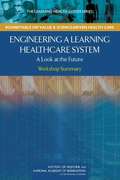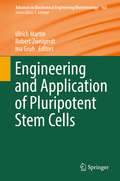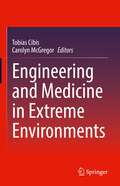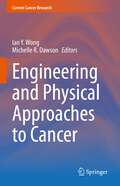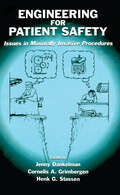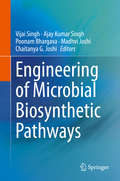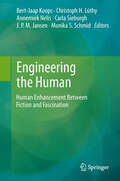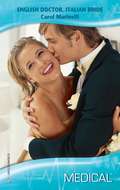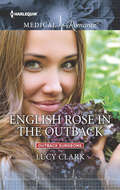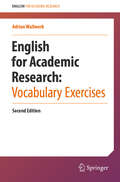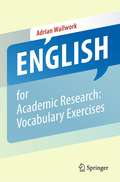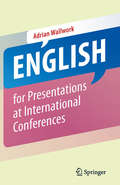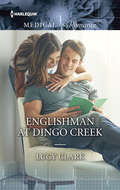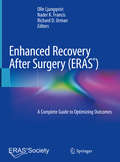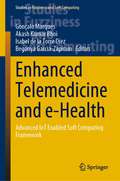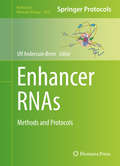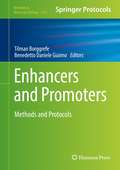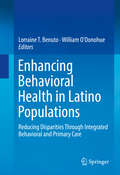- Table View
- List View
Engineering a Learninghealthcare System
by The National Academy of SciencesImproving our nation's healthcare system is a challenge which, because of its scale and complexity, requires a creative approach and input from many different fields of expertise. Lessons from engineering have the potential to improve both the efficiency and quality of healthcare delivery. The fundamental notion of a high-performing healthcare system--one that increasingly is more effective, more efficient, safer, and higher quality--is rooted in continuous improvement principles that medicine shares with engineering. As part of its Learning Health System series of workshops, the Institute of Medicine's Roundtable on Value and Science-Driven Health Care and the National Academy of Engineering, hosted a workshop on lessons from systems and operations engineering that could be applied to health care. Building on previous work done in this area the workshop convened leading engineering practitioners, health professionals, and scholars to explore how the field might learn from and apply systems engineering principles in the design of a learning healthcare system. Engineering a Learning Healthcare System: A Look at the Future: Workshop Summaryfocuses on current major healthcare system challenges and what the field of engineering has to offer in the redesign of the system toward a learning healthcare system.
Engineering and Application of Pluripotent Stem Cells (Advances in Biochemical Engineering/Biotechnology #163)
by Ulrich Martin Robert Zweigerdt Ina GruhThis book reviews the latest biotechnological advances with pluripotent stem cells, exploring their application in tissue engineering and medicinal chemistry. Chapters from expert contributors cover topics such as the production of transgene-free induced pluripotent stem cells (iPSCs), expansion, controlled differentiation and programming of pluripotent stem cells, and their genetic instability. Particular attention is given to the application of the pluripotent stem cells for vascularision of engineered tissue and for drug screening.This book will appeal to researchers working in regenerative medicine and drug discovery, and to bioengineers and professionals interested in stem cell research.
Engineering and Medicine in Extreme Environments
by Tobias Cibis Carolyn McGregor AmThis book brings together in-depth information on a wide array of bio-engineering topics and their application to enhance human health, performance, comfort, and survival in extreme environments. Contributions from biomedical engineering, information systems, medicine and physiology, and medical engineering are presented in relation to a broad range of harsh and extreme environmental scenarios, including underwater, terrestrial (both natural and man-made), and space travel. Physicians, engineers, and scientists, as well as researchers and graduate students, will find the book to be an invaluable resource.Details effects of extreme environments on human physiology;Presents human-environment interaction in different scenarios;Overview of engineering challenges and problems in extreme environments.
Engineering and Physical Approaches to Cancer (Current Cancer Research)
by Ian Y. Wong Michelle R. DawsonEngineering and Physical Approaches to Cancer addresses the newest research at this interface between cancer biology and the physical sciences. Several chapters address the mechanobiology of collective and individual cell migration, including experimental, theoretical, and computational perspectives. Other chapters consider the crosstalk of biological, chemical, and physical cues in the tumor microenvironment, including the role of senescence, polyploid giant cells, TGF-beta, metabolism, and immune cells. Further, chapters focus on circulating tumor cells and metastatic colonization, highlighting both bioengineered models as well as diagnostic technologies. Further, this book features the work of emerging and diverse investigators in this field, who have already made impressive cross-disciplinary scientific contributions. This book is designed for a general audience, particularly researchers conversant in cancer biology but less familiar with engineering (and vice-versa). Thus, we envision that this book will be suitable for faculty, postdoctoral fellows, and advanced graduate students across medicine, biological sciences, and engineering. We also anticipate this book will be of interest to medical professionals and trainees, as well as researchers in the pharmaceutical and biomedical device industry.Describes physical aspects of cancer, including collective cell migration, the aberrant tumor microenvironment, circulating tumor cells, and metastatic colonization. First volume available on the topic of physical aspects of cancer
Engineering for Patient Safety: Issues in Minimally Invasive Procedures (Human Error and Safety)
by Jenny Dankelman Henk G. Stassen Comelis A. GrimbergenThis is a brief study of how human factors engineers have worked with medical personnel to improve patient safety and reduce medical error in the newest minimally invasive surgical procedures (laparoscopy, angioplasty, colonoscopy, etc).
Engineering in Translational Medicine
by Weibo CaiThis book covers a broad area of engineering research in translational medicine. Leaders in academic institutions around the world contributed focused chapters on a broad array of topics such as: cell and tissue engineering (6 chapters), genetic and protein engineering (10 chapters), nanoengineering (10 chapters), biomedical instrumentation (4 chapters), and theranostics and other novel approaches (4 chapters). Each chapter is a stand-alone review that summarizes the state-of-the-art of the specific research area. Engineering in Translational Medicine gives readers a comprehensive and in-depth overview of a broad array of related research areas, making this an excellent reference book for scientists and students both new to engineering/translational medicine and currently working in this area. The ability for engineering approaches to change biomedical research are increasing and having significant impact. Development of basic assays and their numerous applications are allowing for many new discoveries and should eventually impact human health. This book brings together many diverse yet related topics to give the reader a solid overview of many important areas that are not found together elsewhere. Dr. Weibo Cai has taken great care to select key research leaders of many sub-disciplines who have put together very detailed chapters that are easy to read yet highly rich in content. _______________ This book brings together many diverse yet related topics to give the reader a solid overview of many important areas that are not found together elsewhere. Dr. Weibo Cai has taken great care to select key research leaders of many sub-disciplines who have put together very detailed chapters that are easy to read yet highly rich in content. It is very exciting to see such a great set of chapters all together to allow one to have a key understanding of many different areas including cell, gene, protein, and nano engineering as well as the emerging field of theranostics. I am sure the readers will find this collection of important chapters helpful in their own research and understanding of how engineering has and will continue to play a critical role in biomedical research and clinical translation Sanjiv Sam Gambhir M. D. , Ph. D. Stanford University, USA Engineering in Translational Medicine is a landmark book bridging the fields of engineering and medicine with a focus on translational technologies and methods. In a single, well-coordinated volume, this book brings together contributions from a strong and international scientific cast, broadly covering the topics. The book captures the tremendous opportunities made possible by recent developments in bioengineering, and highlights the potential impact of these advances across a broad spectrum of pressing health care needs. The book can equally serve as a text for graduate level courses, a reference source, a book to be dipped into for pleasure by those working within the field, or a cover-to-cover read for those wanting a comprehensive, yet readable introduction to the current state of engineering advances and how they are impacting translational medicine Simon R. Cherry, Ph. D. University of California, Davis, USA
Engineering of Human Tissues and Implants: An Evolutionary Approach to Implant Design
by Frederick H. SilverThis text presents information on biological control systems, mechanotransduction, tissue structure, and function, as well as properties that can be integrated together to provide improved implant and device designs. This information is needed to develop new diagnostic tests and instruments that provide early diagnostic tests and treatments for diseases.Engineering of Human Tissues and Implants: An Evolutionary Approach to Implant Design provides basic scientific information on the evolutionary design of tissues and organs that are a result of living in a gravitational field. Much of the useful information that is available for the design of implants is based on tissue structure and function derived from light and electron microscopy observations. However, this information is not enough for developing new designs of implants and medical devices since much of the biological response to implants is based on understanding the biological control systems and mechanotransduction that drive many of the responses seen with implanted devices. The book also introduces mechanotransduction as it relates to implant design with an overview of materials and their use in applications that include those materials designed to treat wounds, burns, facial, hernial, ophthalmic, oral, cardiovascular, and tendon/ligaments.This book is intended for biomedical science and engineering students who are learning about artificial implants and medical device development. It will also be of significance to other engineering majors interested in the design of devices for diagnoses and measuring of physiological parameters, as well as to clinicians and researchers who are interested in mechanobiology.
Engineering of Microbial Biosynthetic Pathways
by Ajay Kumar Singh Vijai Singh Poonam Bhargava Madhvi Joshi Chaitanya G. JoshiThis book provides a comprehensive overview of the basic and advanced metabolic engineering technologies used to generate natural metabolites and industrially important biomolecules. Metabolic engineering has the potential to produce large quantities of valuable biomolecules in a renewable and sustainable manner by extending or modifying biosynthetic pathways in a wide range of organisms. It has been successfully used to produce chemicals, drugs, enzymes, amino acids, antibiotics, biofuels, and industrially important pharmaceuticals. The book comprehensively reviews the various metabolites detection, extraction and biosensors and the metabolic engineering of microbial strains for the production of industrially useful enzymes, proteins, organic acids, vitamins and antibiotics, therapeutics, chemicals, and biofuels. It also discusses various genetic engineering and synthetic biology tools for metabolic engineering. In closing, the book discusses ethical, patenting and regulatory issues in the metabolic engineering of microbes. This book is a valuable source not only for beginners in metabolic engineering, but also students, researchers, biotechnology and metabolic engineering based company.
Engineering the Human
by Monika S. Schmid Carla Sieburgh Bert Jaap Koops J.P.M. Jansen Annemiek Nelis Christoph H. LüthyThe volume is collection of articles treating the topic of human improvement/enhancement from a variety of perspectives - philosophical, literary, medical, genetic, sociological, legal etc. The chapters in this volume treat not only those aspects that most immediately come to mind when one thinks of 'human enhancement', such as genetic engineering, cloning, artificial implants and artificial intelligence etc. Somewhat less obvious aspects include evolutionary perspectives in connection with the prolongation of the human lifespan, plastic surgery since its beginnings, and questions such as whether the distinction between 'natural' and 'artificial' can really be drawn at all and how it has been conceived across the ages, or what the legal implications are of recent developments and techniques. Many papers make links to the representation of these developments in popular culture, from Jules Verne through Aldous Huxley to the movie Gattaca, address the hopes and fears that come with them as well as the question how realistic these are. While all chapters are written by scientists at the international top of their respective fields, all are accessible to a non-specialist audience and eminently readable. We believe that they represent a state-of-the art overview of questions that are of interest to a large audience. The book thus targets a non-specialist audience with an interest in philosophical, sociological, scientific and legal issues involved in both traditional and recent matters concerning the desire of mankind to improve itself, the human body, the human mind and the human condition. It is unique in that it brings together all these aspects within a coherent and cohesive collection.
Engineering-Medicine: Principles and Applications of Engineering in Medicine
by Lawrence S. Chan and William C. TangThis transformative textbook, first of its kind to incorporate engineering principles into medical education and practice, will be a useful tool for physicians, medical students, biomedical engineers, biomedical engineering students, and healthcare executives. The central approach of the proposed textbook is to provide principles of engineering as applied to medicine and guide the medical students and physicians in achieving the goal of solving medical problems by engineering principles and methodologies. For the medical students and physicians, this proposed textbook will train them to “think like an engineer and act as a physician”. The textbook contains a variety of teaching techniques including class lectures, small group discussions, group projects, and individual projects, with the goals of not just helping students and professionals to understand the principles and methods of engineering, but also guiding students and professionals to develop real-life solutions. For the biomedical engineers and biomedical engineering students, this proposed textbook will give them a large framework and global perspective of how engineering principles could positively impact real-life medicine. To the healthcare executives, the goal of this book is to provide them general guidance and specific examples of applying engineering principles in implementing solution-oriented methodology to their healthcare enterprises. Overall goals of this book are to help improve the overall quality and efficiency of healthcare delivery and outcomes.
English Doctor, Italian Bride
by Carol MarinelliSix years ago, English consultant Hugh Armstrong was welcomed into the Azetti family when he was far from home, and he unwittingly stole the heart of their youngest daughter, Bonny. Their passion culminated in one earth-shattering kiss. Hugh, realizing that seducing their daughter was no way to repay the family for their kindness, quickly retreated to England. Now Hugh has returned to Australia, and not only is he the heartthrob of the emergency department, he is also Nurse Bonny's boss. She seems more out of bounds than ever, but his desire to help Bonny through her father's illness only makes their bond and passion stronger. Will Hugh find the courage to step out of line for the beautiful woman who has captured his heart, and finally make her his, once and for all?
English Rose in the Outback
by Lucy ClarkThe lady and the surgeon! Lady Daisy Forsythe-York has left the army hoping for a new adventure as a doctor in the Outback. She never expects to find it by fainting into the arms of handsome surgeon Oscar Price on her first day! Oscar isn't looking for love, but there's something about Daisy! And when they spend an unexpected night together, the Outback surgeon ignites all Daisy's desires... Could Oscar's reawakening of buttoned-up Daisy lead to more than these two guarded hearts ever expected?
English and Reflective Writing Skills in Medicine: A Guide for Medical Students and Doctors (Radcliffe Ser.)
by Clive Handler Charlotte Handler Deborah GillReflective writing is an established and integral part of undergraduate medical curricula, and also features in postgraduate medical education and revalidation. This book guides and teaches medical students - and all medical and paramedical staff - through the process of writing reflective essays and less formal reflective pieces clearly, concisely, and accurately. Sections on English writing skills, alongside anonymised successful and unsuccessful examples of reflected essays, explore both the principles and practice of effective writing. This clear, practical book is a valuable resource for medical undergraduates and postgraduates, whether English be their first or an additional language.
English for Academic Research: Vocabulary Exercises (English for Academic Research)
by Adrian WallworkThis book is based on a study of referees' reports and letters from journal editors on reasons why papers written by non-native researchers are rejected due to problems with English (long sentences, redundancy, poor structure etc.). It draws on English-related errors from around 5000 papers written by non-native authors, around 3000 emails, 500 abstracts by PhD students, and over 1500 hours of teaching researchers how to write and present research papers. The exercises are organized into thirteen chapters on: adjectives and adverbs (e.g. actual vs current, different vs several, continually vs continuously), link words (e.g. on the contrary vs on the other hand, despite vs nevertheless), nouns (e.g. danger vs hazard, measure vs measurement), prepositions (e.g. among vs between, in vs into, with vs within), verbs (e.g. check vs control, compose vs comprise, arise vs raise, exclude vs rule out), false friends and synonyms, spelling, useful phrases, inclusive vocabulary, emails, using Large Language Models for correcting, paraphrasing, and translating.Nearly all exercises require no actual writing but simply choosing between various options, thus facilitating self-study, e-reading and rapid progress.The exercises can also be integrated into English for Academic Purposes (EAP) and English for Special Purposes (ESP) courses at universities and research institutes.The book can be used in conjunction with the other exercise books in the series:English for Academic Research: Writing ExercisesEnglish for Academic Research: Grammar ExercisesAdrian Wallwork edits scientific papers and teaches English for Academic Purposes (EAP) to PhD students. In addition to his many books for Springer, he has written course books for Oxford University Press and discussion books for Cambridge University Press.
English for Academic Research: Vocabulary Exercises
by Adrian WallworkThis book is based on a study of referees' reports and letters from journal editors on reasons why papers written by non-native researchers are rejected due to problems with English (long sentences, redundancy, poor structure etc). It draws on English-related errors from around 5000 papers written by non-native authors, around 3000 emails, 500 abstracts by PhD students, and over 1000 hours of teaching researchers how to write and present research papers. The exercises are organized into nine chapters on: adjectives and adverbs (e.g. actual vs current, different vs several, continually vs continuously), link words (e.g. on the contrary vs on the other hand, despite vs nevertheless), nouns (e.g. danger vs hazard, measure vs measurement), prepositions (e.g. among vs between, in vs into, with vs within), verbs (e.g. check vs control, compose vs comprise, arise vs raise, exclude vs rule out), false friends and synonyms, spelling, useful phrases, emails Nearly all exercises require no actual writing but simply choosing between various options, thus facilitating self-study, e-reading and rapid progress. The exercises can also be integrated into English for Academic Purposes (EAP) and English for Special Purposes (ESP) courses at universities and research institutes. The book can be used in conjunction with the other exercise books in the series: English for Academic Research: Writing Exercises English for Academic Research: Grammar Exercises
English for Biomedical Scientists
by Rafael F. Duarte Ramón Ribes Palma IannarelliBiomedical scientists are the most likely health care professionals to actually move to an English-speaking country to continue professional training and career-development. This book should help to apply for jobs, write résumés, face job interviews and settle into a new working environment in English. The practical approach of the units will boost the readers' self-confidence in their own English-capabilities. This book should help reducing the anticipated stress of having to learn important matters directly "on the job", and secure more efficient and productive communication from the start.
English for Presentations at International Conferences
by Adrian WallworkGood presentation skills are key to a successful career in academia. This book is the first guide to giving presentations at international conferences specifically written for researchers of all disciplines whose first language is not English.<P><P> With easy-to-follow rules and tips, and with examples taken from real presentations, you will learn how to:<P> * avoid errors in English by using short easy-to-say sentences<P> * improve your English pronunciation and intonation<P> * gain confidence, and overcome nerves and embarrassment<P> * plan, prepare and practice a well-organized, interesting presentation<P> * highlight the essential points you want your audience to remember<P> * deal with questions from the audience<P> * decide what to say at each stage of the presentation<P> * use standard phrases<P> * attract and retain audience attention
English for Presentations at International Conferences, Second edition
by Adrian WallworkGood presentation skills are key to a successful career in academia. This guide provides examples taken from real presentations given both by native and non-native academics covering a wide variety of disciplines.<P><P> The easy-to-follow guidelines and tips will teach you how to: <P> * plan, prepare and practice a well-organized, interesting presentation<P> * avoid errors in English by using short easy-to-say sentences<P> * improve your English pronunciation and intonation<P> * gain confidence, and overcome nerves and embarrassment<P> * highlight the essential points you want your audience to remember<P> * attract and retain audience attention<P> * deal with questions from the audience<P> This new edition contains several additional features, including stimulating factoids and discussion points both for self-study and in-class use. New chapters also cover:<P> * learning from talks on TED<P> * networking with potential collaborators, professors, fellow researchers<P> * interacting successfully with non-native audiences<P> * posters<P> EAP teachers will find this book to be a great source of tips for training students, and for preparing both instructive and entertaining lessons.
Englishman at Dingo Creek
by Lucy ClarkDr Dannyella Thompson needed help with her practice, but an English doctor at Dingo Creek? She was expecting more amusement than assistance But Dr Sebastian MacKenzie proved Dannyella wrong. By the time his two week stay was up he'd won her over - in every way
Enhanced Recovery After Surgery: A Complete Guide to Optimizing Outcomes
by Richard D. Urman Olle Ljungqvist Nader K. FrancisThis book is the first comprehensive, authoritative reference that provides a broad and comprehensive overview of Enhanced Recovery After Surgery (ERAS). Written by experts in the field, chapters analyze elements of care that are both generic and specific to various surgeries. It covers the patient journey through such a program, commencing with optimization of the patient’s condition, patient education, and conditioning of their expectations. Organized into nine parts, this book discusses metabolic responses to surgery, anaesthetic contributions, and optimal fluid management after surgery. Chapters are supplemented with examples of ERAS pathways and practical tips on post-operative pain control, feeding, mobilization, and criteria for discharge. Enhanced Recovery After Surgery: A Complete Guide to Optimizing Outcomes is an indispensable manual that thoroughly explores common post-operative barriers and challenges.
Enhanced Telemedicine and e-Health: Advanced IoT Enabled Soft Computing Framework (Studies in Fuzziness and Soft Computing #410)
by Akash Kumar Bhoi Gonçalo Marques Isabel de la Torre Díez Begonya Garcia-ZapirainIn recent years, new applications on computer-aided technologies for telemedicine have emerged. Therefore, it is essential to capture this growing research area concerning the requirements of telemedicine. This book presents the latest findings on soft computing, artificial intelligence, Internet of Things and related computer-aided technologies for enhanced telemedicine and e-health. Furthermore, this volume includes comprehensive reviews describing procedures and techniques, which are crucial to support researchers in the field who want to replicate these methodologies in solving their related research problems. On the other hand, the included case studies present novel approaches using computer-aided methods for enhanced telemedicine and e-health. This volume aims to support future research activities in this domain. Consequently, the content has been selected to support not only academics or engineers but also to be used by healthcare professionals.
Enhancement in Drug Delivery
by Elka Touitou Brian W. BarryProviding a significant cross-fertilization of ideas across several disciplines, Enhancement in Drug Delivery offers a unique comprehensive review of both theoretical and practical aspects of enhancement agents and techniques used for problematic administration routes. It presents an integrated evaluation of absorption enhancers and modes fo
Enhancer RNAs
by Ulf Andersson ØromThis volume provides a comprehensive overview of the experimental and computational methodologies used to study the function of long non-coding RNA (ncRNAs) expressed from enhancers. Chapter detail both wet-lab and dry-lab techniques and annotating long ncRNAs and exploring transcription by assessing where transcription starts and generally how it occurs.Written in the highly successful Methods in Molecular Biology series format, chapters include introductions to their respective topics, lists of the necessary materials and reagents, step-by-step, readily reproducible laboratory protocols, and tips on troubleshooting and avoiding known pitfalls. Authoritative and cutting-edge, Enhancer RNAs: Methods and Protocols aims to ensure successful results in this rapidly developing field.
Enhancers and Promoters: Methods and Protocols (Methods in Molecular Biology #2351)
by Tilman Borggrefe Benedetto Daniele GiaimoThis volume contains cutting-edge techniques to study the function of enhancers and promoters in depth. Chapters are divided into six sections and describe enhancer-promoter transcripts, nucleosome occupancy, DNA accessibility, chromatin interactions, protein-DNA interactions, functional analyses, and DNA methylation assays. Written in the Methods in Molecular Biology series format, chapters include comprehensive introductions, lists of the necessary materials and reagents, step-by-step laboratory protocols, and useful suggestions for troubleshooting.Authoritative and cutting-edge, Enhancers and Promoters: Methods and Protocols is a useful guide for future experiments.
Enhancing Behavioral Health in Latino Populations
by William O'Donohue Lorraine T. BenutoThis timely volume examines the potential of integrated care in providing effective, accessible behavioral healthcare for Latino clients. The integrated care model is discussed in practical terms, with guidelines for the addressing the needs of Latinos in a coordinated, patient-focused setting. Specific points of attention include common behavioral and medical/mental health conditions (e. g. , depression, chronic pain, tobacco use), special considerations in working with Puerto Rican and Cuban clients, and recommendations for working with children. These important issues are considered against the backdrop of opportunities and challenges inherent in integrated care and its implementation, in addition to the relevance of evidence-based interventions for this large and diverse population. Among the topics covered: Latino trends and health policy: from walking on eggshells to commitment Integrated health care for Latino immigrants and refugees: what do they need? Using a translator in integrated care settings Enhancing and improving treatment engagement with Hispanic patients Integrated depression care among Latinos Chronic disease management and integrated care among Hispanic populations Health psychologists, social workers, family physicians, and clinical psychologists will find Enhancing Behavioral Health in Latino Populations an important resource for their professional development, as well as part of the ongoing movement toward reduced disparities and more inclusive and culturally attuned care.
